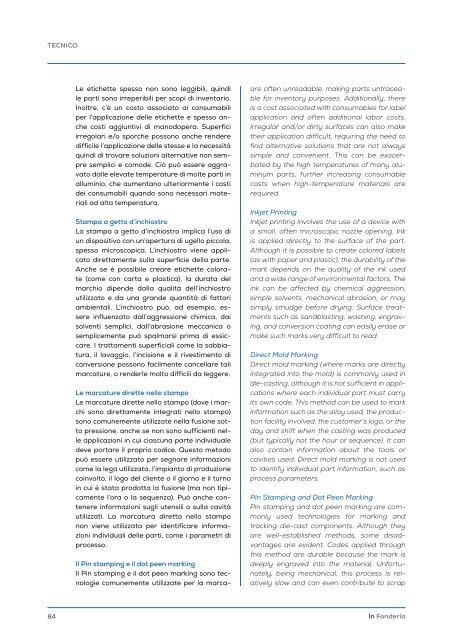In Fonderia 6 2023
Sesto numero del 2023 di In Fonderia
Sesto numero del 2023 di In Fonderia
You also want an ePaper? Increase the reach of your titles
YUMPU automatically turns print PDFs into web optimized ePapers that Google loves.
TECNICO<br />
Le etichette spesso non sono leggibili, quindi<br />
le parti sono irreperibili per scopi di inventario.<br />
<strong>In</strong>oltre, c’è un costo associato ai consumabili<br />
per l’applicazione delle etichette e spesso anche<br />
costi aggiuntivi di manodopera. Superfici<br />
irregolari e/o sporche possono anche rendere<br />
difficile l’applicazione delle stesse e la necessità<br />
quindi di trovare soluzioni alternative non sempre<br />
semplici e comode. Ciò può essere aggravato<br />
dalle elevate temperature di molte parti in<br />
alluminio, che aumentano ulteriormente i costi<br />
dei consumabili quando sono necessari materiali<br />
ad alta temperatura.<br />
Stampa a getto d’inchiostro<br />
La stampa a getto d’inchiostro implica l’uso di<br />
un dispositivo con un’apertura di ugello piccola,<br />
spesso microscopica. L’inchiostro viene applicato<br />
direttamente sulla superficie della parte.<br />
Anche se è possibile creare etichette colorate<br />
(come con carta e plastica), la durata del<br />
marchio dipende dalla qualità dell’inchiostro<br />
utilizzato e da una grande quantità di fattori<br />
ambientali. L’inchiostro può, ad esempio, essere<br />
influenzato dall’aggressione chimica, dai<br />
solventi semplici, dall’abrasione meccanica o<br />
semplicemente può spalmarsi prima di essiccare.<br />
I trattamenti superficiali come la sabbiatura,<br />
il lavaggio, l’incisione e il rivestimento di<br />
conversione possono facilmente cancellare tali<br />
marcature, o renderle molto difficili da leggere.<br />
Le marcature dirette nello stampo<br />
Le marcature dirette nello stampo (dove i marchi<br />
sono direttamente integrati nello stampo)<br />
sono comunemente utilizzate nella fusione sotto<br />
pressione, anche se non sono sufficienti nelle<br />
applicazioni in cui ciascuna parte individuale<br />
deve portare il proprio codice. Questo metodo<br />
può essere utilizzato per segnare informazioni<br />
come la lega utilizzata, l’impianto di produzione<br />
coinvolto, il logo del cliente o il giorno e il turno<br />
in cui è stata prodotta la fusione (ma non tipicamente<br />
l’ora o la sequenza). Può anche contenere<br />
informazioni sugli utensili o sulla cavità<br />
utilizzati. La marcatura diretta nello stampo<br />
non viene utilizzata per identificare informazioni<br />
individuali delle parti, come i parametri di<br />
processo.<br />
Il Pin stamping e il dot peen marking<br />
Il Pin stamping e il dot peen marking sono tecnologie<br />
comunemente utilizzate per la marcaare<br />
often unreadable, making parts untraceable<br />
for inventory purposes. Additionally, there<br />
is a cost associated with consumables for label<br />
application and often additional labor costs.<br />
Irregular and/or dirty surfaces can also make<br />
their application difficult, requiring the need to<br />
find alternative solutions that are not always<br />
simple and convenient. This can be exacerbated<br />
by the high temperatures of many aluminum<br />
parts, further increasing consumable<br />
costs when high-temperature materials are<br />
required.<br />
<strong>In</strong>kjet Printing<br />
<strong>In</strong>kjet printing involves the use of a device with<br />
a small, often microscopic nozzle opening. <strong>In</strong>k<br />
is applied directly to the surface of the part.<br />
Although it is possible to create colored labels<br />
(as with paper and plastic), the durability of the<br />
mark depends on the quality of the ink used<br />
and a wide range of environmental factors. The<br />
ink can be affected by chemical aggression,<br />
simple solvents, mechanical abrasion, or may<br />
simply smudge before drying. Surface treatments<br />
such as sandblasting, washing, engraving,<br />
and conversion coating can easily erase or<br />
make such marks very difficult to read.<br />
Direct Mold Marking<br />
Direct mold marking (where marks are directly<br />
integrated into the mold) is commonly used in<br />
die-casting, although it is not sufficient in applications<br />
where each individual part must carry<br />
its own code. This method can be used to mark<br />
information such as the alloy used, the production<br />
facility involved, the customer’s logo, or the<br />
day and shift when the casting was produced<br />
(but typically not the hour or sequence). It can<br />
also contain information about the tools or<br />
cavities used. Direct mold marking is not used<br />
to identify individual part information, such as<br />
process parameters.<br />
Pin Stamping and Dot Peen Marking<br />
Pin stamping and dot peen marking are commonly<br />
used technologies for marking and<br />
tracking die-cast components. Although they<br />
are well-established methods, some disadvantages<br />
are evident. Codes applied through<br />
this method are durable because the mark is<br />
deeply engraved into the material. Unfortunately,<br />
being mechanical, this process is relatively<br />
slow and can even contribute to scrap<br />
84<br />
<strong>In</strong> <strong>Fonderia</strong>














